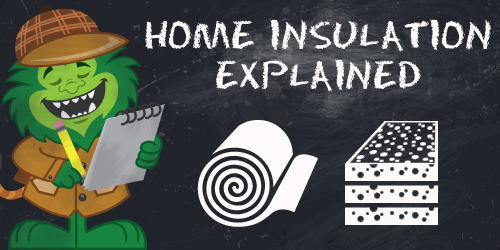
Insulation is one of the most important tools you have for managing your home’s overall comfort and energy consumption. Insulation comes in many different materials and can be installed using several different techniques. Before we look at the different types of insulation, we need a way to compare the effectiveness of one type of insulation against another.
Measuring Effectiveness
Being able to determine the effectiveness of different types of insulation is essential in choosing which type to use. The purpose of insulation is to stop the transfer of heat and each type of insulation has a rating of how well the material resists heat flow through it. The higher the R-value, or resistance value, the greater the material resists heat flow, therefore the greater its insulating capability.
Fiberglass Insulation
Fiberglass is one of the most common materials used for insulation. It is made from very fine fibers of glass and usually comes in rolls, duct insulation pieces, or loose-fill. The effectiveness of fiberglass rolls can vary greatly depending on the width and thickness of the installation, the backing and facing material, and the density of the fiberglass. Most fiberglass batts have an R-value of around 3.7 per inch and its effectiveness can be increased by layering the batts.
Fiberglass insulation is a popular choice among homeowners because it is easy to obtain, easy to install, and it is relatively inexpensive. No special equipment is necessary to install, it simply sits between studs and joists.
Cellulose Insulation
Another common choice, cellulose, is made from about 85% recycled paper with minerals added to create a fire- and insect-resistant material. It has an R-value of about 3.7 per inch and is installed using a specialized blower machine that sprays several inches of the material into the space.
Cellulose is an excellent choice because it provides complete coverage around obstacles and when applied correctly, the densely packed material prevents drafts and blocks the transmission of sound better than fiberglass. Recent studies also suggest that cellulose insulation may be more fire-resistant than fiberglass and the cost per square foot is about the same.
Additional Fiber Types
- Plastic. Usually made from recycled milk containers, it comes in batts and rolls similar to fiberglass and has an R-value around 4 per inch.
- Cotton. Made from 85% recycled cotton along with plastic and fire-retardant minerals, cotton insulation is available in batts and rolls and has an R-value around 3.4 per inch.
- Wool. Typically sheep’s wool is used and it is treated with the same minerals as other fibrous insulation for fire resistance and has an R-value around 3.5 per inch.
Polystyrene Insulation
This material comes in the form of boards, blocks, or as a loose-fill material. The loose-fill beads can be used to pour into hollow cavities like walls and concrete blocks, however, they can be messy and difficult to control. Extruded polystyrene comes in boards and is more manageable. There has recently been some cause for concern about the chemicals used for fire-resistance, however, and many green builders are moving towards other materials.
Polyisocyanurate and Polyurethane Insulation
These materials are available in sprayable foam or in boards. When foamed in place, the materials will expand and form around building structures giving a nearly airtight installation. Panels made from polyiso and polyurethane are usually covered with foil and plastic facings that can help stabilize the material and reduce deterioration. If a reflective material is used as a facing it can act as a radiant barrier making it even more efficient and keeping heat where you want it. Insulation made from these materials provide an R-value of about 7 per inch. It can be difficult to install in existing situations but makes an excellent choice for new construction or renovations.
Which insulation is the right choice?
Determining which insulating material is right for you depends on what area of the home needs insulating, how much insulating power is necessary, and how many square feet you need to install. Comparing your needs with your budget will help make sure you get the best material for your home. Find out how well your current insulation stacks up by scheduling a free energy audit today.







